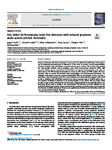NH2 linker for femtomolar label-free detection with reduced graphene oxide screen-printed electrodes
| dc.contributor.author | Sethi, J | |
| dc.contributor.author | Suhail, A | |
| dc.contributor.author | Safarzadeh, Mina | |
| dc.contributor.author | Sattar, A | |
| dc.contributor.author | Wei, Yinghui | |
| dc.contributor.author | Pan, Genhua | |
| dc.date.accessioned | 2021-11-23T12:02:48Z | |
| dc.date.available | 2021-11-23T12:02:48Z | |
| dc.date.issued | 2021-07 | |
| dc.identifier.issn | 0008-6223 | |
| dc.identifier.issn | 1873-3891 | |
| dc.identifier.uri | http://hdl.handle.net/10026.1/18405 | |
| dc.description.abstract |
Surface modification with linker molecules is necessary for the effective immobilization of bioreceptors and for improving the performance of biosensors. In this work, we present a novel functionalization technique to attach amine (NH2) linker on graphene-based sensor surfaces. This is achieved by reacting the commercially available reduced graphene oxide (rGO) screen-printed electrodes (SPEs) with ammonia solution at room temperature. The NH2 linkers are attached predominantly on the edge and defect sites of rGO SPE through chemisorption as shown by XPS, Raman and FTIR analysis. The functionalized SPEs are further characterized using morphological and electrochemical techniques. The validation of the linker is done by using the functionalized SPEs for the detection of Aβ1-40 and Aβ1-42 biomarkers. A limit of detection (LOD) of 9.51 fM is achieved over a linear dynamic range of 10 fM-10 pM for Aβ1-40. Similarly, LOD of 8.65 fM is achieved over a linear dynamic range of 10 fM-50 pM for Aβ1-42. This excellent sensitivity is attributed to the functionalization of rGO surface with NH2 linker, which provides a large number of binding sites for bioreceptors. High specificity for the target biomarkers over interfering Aβ and ApoE ε4 species is also demonstrated. The biosensor is further validated for the analysis of spiked human plasma. The proposed technique provides a promising approach for improving the detection sensitivity of graphene biosensors for application in biofluids based minimally invasive and cost- and time-efficient disease diagnosis. | |
| dc.format.extent | 514-522 | |
| dc.language | en | |
| dc.language.iso | en | |
| dc.publisher | Elsevier | |
| dc.subject | NH2 linker | |
| dc.subject | Reduced graphene oxide | |
| dc.subject | Label-free | |
| dc.subject | Electrochemical biosensors | |
| dc.subject | Beta-amyloid | |
| dc.subject | Alzheimer's disease | |
| dc.title | NH2 linker for femtomolar label-free detection with reduced graphene oxide screen-printed electrodes | |
| dc.type | journal-article | |
| dc.type | Journal Article | |
| plymouth.author-url | https://www.webofscience.com/api/gateway?GWVersion=2&SrcApp=PARTNER_APP&SrcAuth=LinksAMR&KeyUT=WOS:000661625400051&DestLinkType=FullRecord&DestApp=ALL_WOS&UsrCustomerID=11bb513d99f797142bcfeffcc58ea008 | |
| plymouth.volume | 179 | |
| plymouth.publication-status | Published | |
| plymouth.journal | Carbon | |
| dc.identifier.doi | 10.1016/j.carbon.2021.04.074 | |
| plymouth.organisational-group | /Plymouth | |
| plymouth.organisational-group | /Plymouth/Faculty of Science and Engineering | |
| plymouth.organisational-group | /Plymouth/Faculty of Science and Engineering/School of Engineering, Computing and Mathematics | |
| plymouth.organisational-group | /Plymouth/REF 2021 Researchers by UoA | |
| plymouth.organisational-group | /Plymouth/REF 2021 Researchers by UoA/EXTENDED UoA 10 - Mathematical Sciences | |
| plymouth.organisational-group | /Plymouth/REF 2021 Researchers by UoA/UoA10 Mathematical Sciences | |
| plymouth.organisational-group | /Plymouth/REF 2021 Researchers by UoA/UoA12 Engineering | |
| plymouth.organisational-group | /Plymouth/Users by role | |
| plymouth.organisational-group | /Plymouth/Users by role/Academics | |
| plymouth.organisational-group | /Plymouth/Users by role/Researchers in ResearchFish submission | |
| dcterms.dateAccepted | 2021-04-23 | |
| dc.rights.embargodate | 2021-11-24 | |
| dc.identifier.eissn | 1873-3891 | |
| dc.rights.embargoperiod | Not known | |
| rioxxterms.versionofrecord | 10.1016/j.carbon.2021.04.074 | |
| rioxxterms.licenseref.uri | http://www.rioxx.net/licenses/all-rights-reserved | |
| rioxxterms.licenseref.startdate | 2021-07 | |
| rioxxterms.type | Journal Article/Review |


